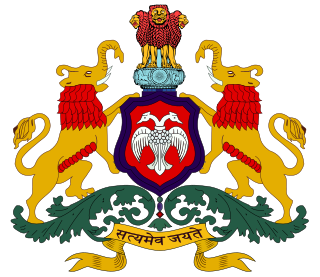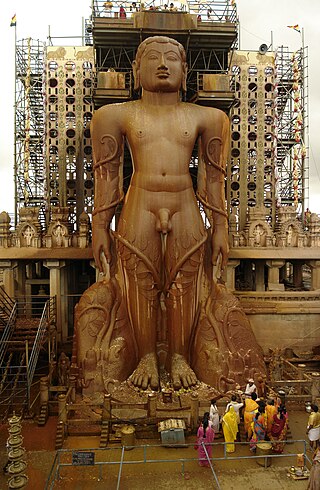
Bangalore Division, officially Bengaluru division, is one of the four divisions of the Indian state Karnataka. The division comprises the districts of Bangalore Urban, Bangalore Rural, Chikkaballapur, Chitradurga, Davanagere, Kolar, Ramanagara, Shimoga, and Tumakuru.The total area of the division is 49,936 km2. The total population as of 2011 census is 22,523,301, making it the world's fifth most populous sub-division.

National Highway 4 was a major National Highway before National Highway renumbering in Western and Southern India. NH 4 linked four of the 10 most populous Indian cities – Mumbai, Pune, Bangalore, and Chennai. NH 4 was 1,235 km (767 mi) in length and passed through the states of Maharashtra, Karnataka b'lore and Tamil Nadu. It is now numbered as National Highway 48 (India). National Highway 4 was known as P.B.Road in many parts of Maharashtra and Karnataka states before it was renumbered.
The Mysore plateau, also known as the South Karnataka plateau, is a plateau that is one of the four geographically unique regions of the Indian state of Karnataka. It has many undulations and is bounded on the west and south by the Western Ghats. Most of the river Kaveri flows through Karnataka in the Mysore Plateau. The average elevation in the region is between 600 and 900 meters. The plateau covers the districts of Bangalore, Bangalore Rural, Chamarajanagar, Hassan, Kodagu, Kolar, Mandya, Mysore and Tumkur.

The Government of Karnataka, abbreviated as GoK or GOKA, or simply Karnataka Government, formerly Government of Mysore or Government of Mysore State is a democratically elected state body with the governor as the ceremonial head to govern the Southwest Indian state of Karnataka. The governor who is appointed for five years appoints the chief minister and on the advice of the chief minister appoints their council of ministers. Even though the governor remains the ceremonial head of the state, the day-to-day running of the government is taken care of by the chief minister and their council of ministers in whom a great amount of legislative powers are vested.
The Mysore region is an unofficial region that is part of Karnataka state in southern India. It forms approximately the southern half of the non-coastal areas of that state. The area corresponds almost exactly to that of the erstwhile princely state of Mysore. Almost all of that principality, with the exception of a few areas that now lie in neighbouring states, is comprehended by this term.

North Karnataka is a geographical region in Deccan plateau from 300 to 730 metres elevation that constitutes the region of the Karnataka state in India and the region consists of 14 districts. It is drained by the Krishna River and its tributaries the Bhima, Ghataprabha, Malaprabha, and Tungabhadra. North Karnataka lies within the Deccan thorn scrub forests ecoregion, which extends north into eastern Maharashtra.

Karnataka, the sixth largest state in India, has been ranked as the third most popular state in the country for tourism in 2014. It is home to 507 of the 3600 centrally protected monuments in India, second only to Uttar Pradesh. The State Directorate of Archaeology and Museums protects an additional 752 monuments and another 25,000 monuments are yet to receive protection.

The Indian State of Karnataka is located between 11°30' North and 18°30' North latitudes and between 74° East and 78°30' East longitude.It is situated on a tableland where the Western Ghats and Eastern Ghats converge into the complex, in the western part of the Deccan Peninsular region of India. The State is bounded by Maharashtra and Goa States in the north and northwest; by the Lakshadweep Sea in the west; by Kerala in the south-west and Tamil Nadu in the south and south-east, Andhra Pradesh in the south-east and east and Telangana in the north-east. Karnataka extends to about 850 km (530 mi) from north to south and about 450 km (280 mi) from east to west.
Abbanakuppe is a village in the southern state of Karnataka, India. It is located in the Gubbi taluk of Tumkur district.
University of Horticultural Sciences, Bagalkot is a public university dedicated to the study and research of Horticultural Sciences established by the Government of Karnataka at Bagalkot district.

This article gives a list of the territories of the dioceses of the Catholic Church in India.

The following outline is provided as an overview of and topical guide to Karnataka:
The Electricity Supply Companies, also known as ESCOMs, are responsible for electric power distribution in state of Karnataka. Its origin was in Karnataka Electricity Board. This distribution entity was incorporated to provide efficient and reliable electric power supply to the people of Karnataka state
Hebbal may refer to several places in Karnataka, India:
Rajyotsava Awards are awarded every year on November 1, the eve of Karnataka Rajyotsava, the day Karnataka State was formed.








